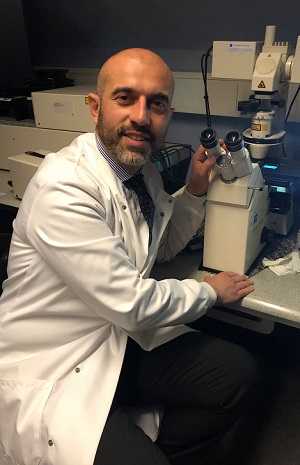Research That Could Hold Key to New Treatments for Cancer and Neurodegeneration
Clinical Connections – Spring 2021
An RVC study has found a new interaction within cells that could lead to the development of novel therapies for cancer and neurodegeneration for veterinary and human patients.
This discovery of direct interaction between mitochondria and nuclei through membrane contact sites expands the understanding of mitochondrion-to-nucleus communication and intracellular signalling.
In mammals, mitochondria are vital organelles acting as primary sources of energy and play a part in several key processes, spanning hormone synthesis and programmed cell death. They are the most successful example of endosymbiosis, the process through which eukaryotic cells host a prokaryote with membrane-bound nucleic acid.
Until very recently, it was understood that mitochondria communicate to the nucleus alterations in the cellular environment to increase the transcription of genes involved in the preservation of mitochondrial and cellular function. This process – mitochondrial retrograde response (MRR) – is ascribed to the deregulation of several pathologies, including cancer and neurodegeneration.
The team, led by Professor Michelangelo Campanella, Chair in Pharmacology and Head of the Mitochondrial Cell Biology and Pharmacology Research Unit, utilised breast cancer cells of different stages of aggressiveness isolated from humans, dogs and cats. In these species, the evolution of cancer of the mammary gland (e.g. breast cancer) meant that their susceptibility to chemotherapy was proven to be associated with the degree of contact sites between mitochondria and nuclei.
%20small.jpg)
Various molecular pharmacology protocols were used throughout the study to induce and control the interaction between mitochondria and nuclei. Added to this, cutting-edge techniques of fluorescent imaging enabled the team to map the dynamic nature of the interaction and transmission electron microscopy to picture the ultrastructure of nucleus-associated mitochondria (NAM).
The breakthrough demonstrates that communication between mitochondria and nucleus is mediated by specific points of contact. The discovery of discrete anatomic compartments offers the possibility to target these selectively and regulate this inter-organelle communication, paving the way for new and improved strategies to impact diseases.

Outlining the significance of the breakthrough, Professor Campanella, who is also Leader of the RVC Oncology Interest Group, said: “This study is the first of its kind to unveil the association between the mitochondrion and nucleus to be a regulated process and can be used to identify how this interplay can be pharmacologically controlled. The impact of this discovery is likely bigger than the advanced comprehension of mammalian cells physiology and pathology, embracing aspects of evolution.”
He also said: “The co-existence of distinct DNAs is just partially understood and how genes from the mitochondria are transferred to genomic DNA is completely unknown. Our research group has now started investigating the molecular determinants of tethering and the involvement of these inter-organellar communication in several disease models. This is truly groundbreaking as it will allow us to develop ways of correcting mitochondrial signalling in pathological conditions, including cancer and neurodegeneration.”
Irina Gramer, Head of the Oncology Service and Lecturer in Veterinary Oncology, added: “Investigations into the dynamic nature of inter-organellar communication will greatly aid our understanding and discovery of potential cancer-inducing signalling pathways. The identification of certain transcription genes involved in cellular function and defining their role in the nucleus mitochondrial communication could determine potential diagnostic and prognostic markers for our oncological patients.
“Such markers would greatly impact treatment decisions in our patients and may overcome diagnostic challenges. Moreover, it could lead to the identification of potential therapeutic targets, allowing the oncologist to implement individually tailored and possibly more effective treatment.”
This research was funded by the Biotechnology and Biological Sciences Research Council (BBSRC), the Petplan Charitable Trust and the European Research Council who sustain the activity of Professor Campanella. The research article, ‘Mitochondria form contact sites with the nucleus to couple prosurvival retrograde response’, is open access on the Science Advances website, published by the American Association for the Advancement of Science.
